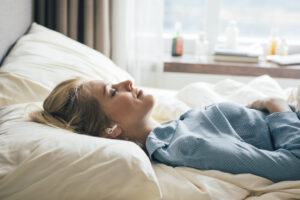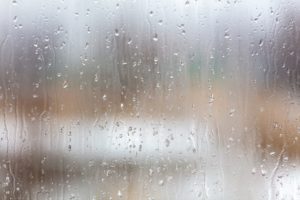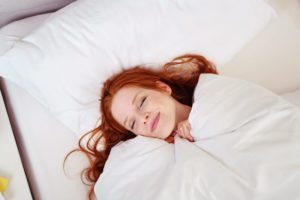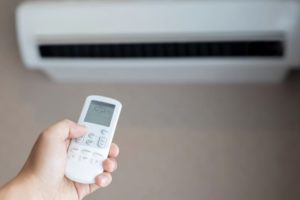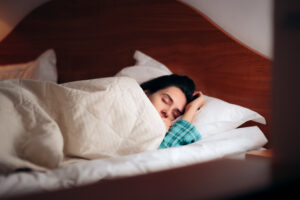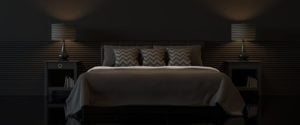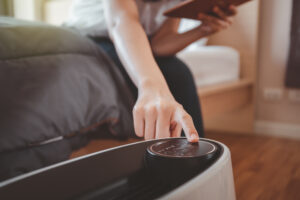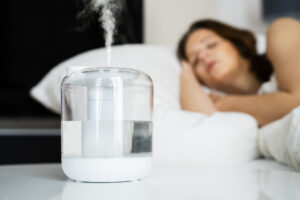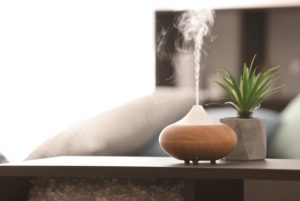How to Sleep When It’s Hot Outside
Our medical review team has recently evaluated this page to ensure accuracy. We will continue to monitor and revise this article as new literature is published on the impact of temperature on sleep.
Most of us have endured the discomfort of trying to sleep on an excessively hot or humid night. Thankfully, there are many different measures you can take to cool down in the evening and maintain a comfortable temperature throughout the night. By the same token, you should avoid certain activities before bed to prevent overheating while sleeping.
Understanding How Temperature Affects Sleep
As part of a normal sleep cycle , your body temperature will begin to decrease in the early evening. This is tied to circadian rhythm, which regulates your sleep, appetite, mood, and other bodily functions, and specifically an area of your brain known as the suprachiasmatic nucleus (SCN).
During the day, the retinas in your eyes perceive natural light and send a signal to the SCN that you should be awake. This stimulates the production of cortisol, a hormone that makes you feel alert, and also keeps your body temperature at its normal waking level, around 98.6 degrees Fahrenheit (37 degrees Celsius). When the sun goes down, your eyes perceive darkness which signals the release of melatonin, the hormone that induces feelings of tiredness and relaxation. This also causes your core temperature to dip.
External temperatures can interfere with the natural thermoregulation that occurs during sleep. If your bedroom is too warm, as it can be in summer, then this can increase your body temperature and disturb your sleep. You are more sensitive to temperatures during the first two sleep stages, and thus more likely to wake up during these stages if you feel hot.
Waking up from sleep can decrease the amount of time you spend in deep sleep, as well as the fourth and final stage of rapid eye movement (REM) sleep. Cell repair, immune system recovery, and other restorative physiological processes occur during these stages and are key to helping you feel well-rested in the morning. Less time in these stages will leaving you feeling tired and less refreshed.
Are You Getting Enough Deep Sleep?
A variety of issues can cause degrade your sleep quality. Answer three questions to understand if it’s a concern you should worry about.
What You Can Do Before Bed
Since maintaining a lower body temperature during sleep is so crucial to your overall health, you may need to take extra precautions for keeping cool when it’s too hot to sleep.
Tips for optimizing your bedroom for cool, comfortable sleep include:

- Draw the curtains: Keeping sunlight out of your bedroom will help your sleep area stay cool, even on exceptionally hot days. Draw the curtains or shades in the morning and do not open them until you go to bed. Many people find blackout curtains, which are designed to block all outside light, are particularly effective at keeping bedrooms cool in the summer and insulating against the cold when temperatures drop.

- Don’t exercise close to bed: Moderate exercise during the day can be very beneficial to sleep, as it expends energy and helps you feel more tired in the evening. However, exercising close to bedtime can cause your body temperature to spike. This can make it more difficult to fall asleep at your desired time.
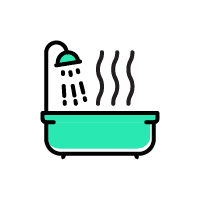
- Take a hot bath: While lying in a tub of warm water might not sound like fun on a hot night, this can actually help you cool down before bed . Hot baths are the most beneficial if taken prior to but not immediately before bedtime. Your body temperature will decrease after you leave the bath as your body adapts to the cooler environment. As an added bonus, baths promote feelings of relaxation that can help you fall asleep more quickly.

- Invest in the right mattress and pillow: Your bed can play a major role in how comfortable you feel during the night. Mattresses made with thick foams tend to absorb and trap body heat, causing you to feel excessively warm. Other mattresses sleep cool by comparison thanks to components like ventilated latex and open coil systems that circulate air throughout the interior. Cooling pillows can have the same effect. Certain pillows can be heat traps, but other types of pillows – such as latex, ventilated foam, and wool – provide above-average temperature control.

- Buy natural bedding: Sheets and pillowcases made from natural fibers like cotton or linen offer better breathability than those made from polyester and other synthetic fabrics. Some people also find bedding made from plant-based fabrics like rayon from bamboo provide adequate cooling.

Ways To Stay Cool While You Sleep
Measures you can take to remain cool and comfortable in bed include:

- Set your thermostat to 65 degrees: Many experts agree that 65 degrees Fahrenheit (18.3 degrees Celsius) is the best temperature for sleep. While it might sound relatively cool, this thermostat setting helps your body maintain its natural core temperature for sleeping. However, everyone has different sleep preferences and a range of 65-68 degrees Fahrenheit is considered reasonable for most people.

- Find your ideal clothing level: Some people prefer wearing pajamas or sweats to bed, while others find sleeping nude or semi-nude more comfortable. Choose the sleeping attire that works best for you, but keep in mind that thick, insulating bedclothes can elevate your body temperature and cause you to overheat in bed – especially on hot or humid nights.

- Use a bedside fan: A reliable box or window fan will circulate air through your room to help you stay cool. Even if you already use an air conditioner, you should consider a fan for the added airflow.

- Keep ice water within reach: A cool glass of water on your nightstand can provide much-needed relief if you wake up due to excessive heat. An ice pack will also work in a pinch, providing cool relief if placed on the back of the neck or under the covers.

- Freeze your pillowcases: For extra cooling when you go to sleep, place your pillowcase in the freezer in the evening and put it on your pillow before getting into bed.
These techniques are not limited to the summertime. If you live in an area where high temperatures are the norm, you may find them useful throughout the calendar year.
References
6 Sources
-
Harding, E., Franks, N., & Wisden, W. (2019). The Temperature Dependence of Sleep. Frontiers in Neuroscience, 13.
https://www.ncbi.nlm.nih.gov/pmc/articles/PMC6491889/ -
Szymusiak, R. (2020). Handbook of Clinical Neurology (Vol. 156). Elsevier.
https://linkinghub.elsevier.com/retrieve/pii/B9780444639127000205 -
Okamoto-Mizuno, K., & Mizuno, K. (2012). Effects of thermal environment on sleep and circadian rhythm. Journal of Physiological Anthropology, 31(1), 14.
https://pubmed.ncbi.nlm.nih.gov/22738673/ -
Breus, M. J. (2017, November 30). Hot Nights Can Disrupt Your Sleep. Psychology Today.
https://www.psychologytoday.com/us/blog/sleep-newzzz/201711/hot-nights-can-disrupt-your-sleep -
National Heart, Blood, and Lung Institute. (2011, September). In Brief: Your Guide to Healthy Sleep.
https://www.nhlbi.nih.gov/files/docs/public/sleep/healthysleepfs.pdf -
Improve Sleep: Tips to Improve Your Sleep When Times Are Tough. CDC. (2020, September 22).
https://blogs.cdc.gov/niosh-science-blog/2020/06/29/sleep-hwd/



